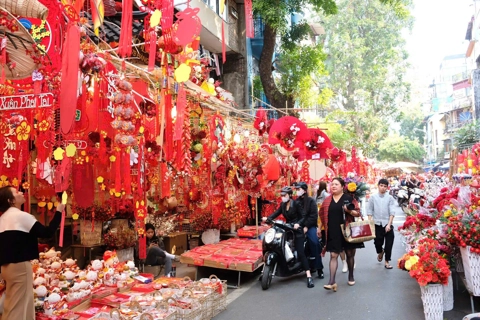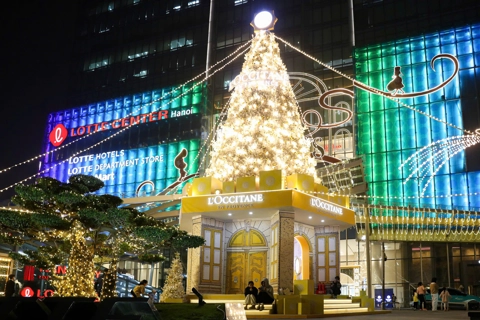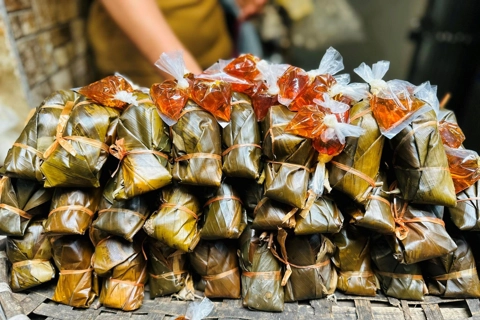Life
Traditional game an art worth preserving
Jan 18, 2015 / 12:02 PM
Bai choi is a unique Vietnamese game combining folklore and a competition. Conservation of the performance art game is crucial to keeping the country`s history alive, attendees of a two-day conference wrapped-up in central Binh Dinh Province on Jan 14, said.
According to Nguyen Binh Dinh, the director of the Viet Nam Institute for Musicology, the art form would be easy to preserve, thanks to its simplicity.
"The art form offers audiences a wide range of performance styles: folk songs, poem-singing, acting, storytelling and music performed on traditional instruments," he said.
Bai choi, which means a deck of cards (bai) and bamboo hut (choi), is a traditional competition combining folklore singing, prize-winning and a memory game. It often takes place on a wide yard in front of communal houses, gathering the entire community together.
The stage, or playing area, is composed of nine or 11 stilt bamboo huts, where teams of players and the game conductor reside. The game conductor draws a card from a deck and sings a tune – accompanied by a traditional band – or cites a poem containing the name of the card. The players must then guess what card the conductor is holding. When a team guesses correctly, they win the card. The first team to get three cards gets a prize.
Bai choi is said to have been invented 400 years ago by a feudal mandarin Dao Duy Tu (1571-1643) looking to entertain people during holidays.
The art is popular in the southern-central provinces of Quang Nam, Quang Ngai, Binh Dinh, Phu Yen and Khanh Hoa. It is also well-known in Quang Binh, Quang Tri and Thua Thien-Hue provinces.
It attained national cultural heritage status in November, and is expected to achieve world heritage status in the near future. Dinh said the institute and local cultural authorities in Binh Dinh Province – which has the most bai choi clubs, about 100 – are applying to get the art form UNESCO intangible world heritage recognition.
The conference's international attendees from Laos, South Korea, Germany, France and Sweden said there are art forms similar to bai choi across the world, and that some of them have already been recognised by UNESCO. This includes South Korea's Pandori art form.
"Bai choi is a very good example of folk creativity and cultural diversity in Vietnamese traditional performing arts," Ebsjorn Watermark, a Swedish folklore researcher, said at the conference.
Other attendees, including Laotian researcher Bountheng Souksavatd and French professor Yves Defrance, said they believed it would be simple to preserve the art form, since it is not so complicated.
The future of cultural heritage items relies on the communities where they were created, said Seong-Yong Park of the International Information and Networking Centre for Intangible Cultural Heritage in Asia and the Pacific (ICHCAP).
Experts said bai choi has the strength to survive in the modern world because of the central region communities' passion to keep it alive. They also believe UNESCO recognition would help keep the preservation process on the right track.
"The art form offers audiences a wide range of performance styles: folk songs, poem-singing, acting, storytelling and music performed on traditional instruments," he said.
Bai choi, which means a deck of cards (bai) and bamboo hut (choi), is a traditional competition combining folklore singing, prize-winning and a memory game. It often takes place on a wide yard in front of communal houses, gathering the entire community together.
The stage, or playing area, is composed of nine or 11 stilt bamboo huts, where teams of players and the game conductor reside. The game conductor draws a card from a deck and sings a tune – accompanied by a traditional band – or cites a poem containing the name of the card. The players must then guess what card the conductor is holding. When a team guesses correctly, they win the card. The first team to get three cards gets a prize.

Fun in the sun: A bai choi performance and the surrounding audience.
|
The art is popular in the southern-central provinces of Quang Nam, Quang Ngai, Binh Dinh, Phu Yen and Khanh Hoa. It is also well-known in Quang Binh, Quang Tri and Thua Thien-Hue provinces.
It attained national cultural heritage status in November, and is expected to achieve world heritage status in the near future. Dinh said the institute and local cultural authorities in Binh Dinh Province – which has the most bai choi clubs, about 100 – are applying to get the art form UNESCO intangible world heritage recognition.
The conference's international attendees from Laos, South Korea, Germany, France and Sweden said there are art forms similar to bai choi across the world, and that some of them have already been recognised by UNESCO. This includes South Korea's Pandori art form.
"Bai choi is a very good example of folk creativity and cultural diversity in Vietnamese traditional performing arts," Ebsjorn Watermark, a Swedish folklore researcher, said at the conference.
Other attendees, including Laotian researcher Bountheng Souksavatd and French professor Yves Defrance, said they believed it would be simple to preserve the art form, since it is not so complicated.
The future of cultural heritage items relies on the communities where they were created, said Seong-Yong Park of the International Information and Networking Centre for Intangible Cultural Heritage in Asia and the Pacific (ICHCAP).
Experts said bai choi has the strength to survive in the modern world because of the central region communities' passion to keep it alive. They also believe UNESCO recognition would help keep the preservation process on the right track.








